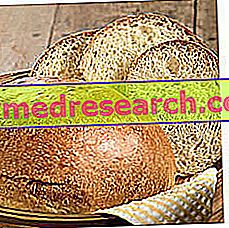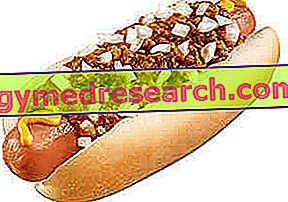Watch the video
X Watch the video on youtubeYeasts in food and intestinal flora
Quite popular among the proponents of various alternative medicines, practically absent in the textbooks of official medicine, we are talking about intolerance to yeasts, a generic expression to indicate a dysbiosis of the intestinal flora with overgrowth of the fungal component, in particular of the yeast Candida albicans . Let's start by saying that often the terms fungi and yeasts are used as synonyms, since yeasts represent single-celled fungi of microscopic size.

The intestinal bacterial flora can be considered a sort of genetic imprint, different from individual to individual and influenced above all by the diet, which tends to favor some microbial species compared to others. Very important, in this sense, is the functionality of the digestive system which - given the same diet - can diversify the quantity of unabsorbed or poorly digested nutrients that reach the colon. Also some drugs, first and foremost antibiotics, corticosteroids and hormonal therapies (birth control pills, oral replacement therapy), can interfere with the microbial flora generating pictures of dysbiosis.
Although the alterations of the intestinal microbial flora find limited space in the textbooks of official medicine, more and more experts and empirical experiences consider them responsible for disturbances which, after all, are not invalidating, but rather widespread in industrialized countries: from food intolerances to imbalances of the immune system and related consequences (increased susceptibility to infections, allergies, autoimmune diseases, etc.), from fungal diseases (especially candida) to disorders of the alvo (diarrhea, constipation, meteorism, flatulence, abdominal cramps etc.), from genital and urinary infections to nutritional deficiencies (especially of vitamins and minerals), from predisposition to colorectal tumors to low physical efficiency, with migraine and a sense of weakness.
Very Easy Pizza without Yeast
X Problems with video playback? Reload from YouTube Go to Video Page Go to Video Recipes Section Watch the video on youtubeYeast intolerances: a personal matter ...
In the face of the aforementioned disorders, very often food intolerances are brought into play, today very fashionable and often overestimated, sometimes confirmed and supported by diagnostic tests of dubious utility or completely unreliable. As often happens, we start from established scientific assumptions (those listed in the introductory part) and then get lost in simplistic reasoning coming to completely misleading conclusions. Let us think, for example, of yeast, the undisputed protagonist of bread leavening and bakery products; the microorganisms that constitute it ( Saccharomyces cerevisiae ) ferment the glucose of the bread producing the carbon dioxide necessary to make it rise; here then that in the face of symptoms like swollen stomach, meteorism and excess of intestinal gas, it is easy to blame an intolerance to yeasts. In reality, the factors involved are innumerable and must be carefully studied to find a solution to this disorder (lactose or gluten intolerance, poor digestive efficacy, overeating in a context of sedentary lifestyle, excessive consumption of carbonated beverages, low or excessive consumption of fibers, digestive intolerance towards particular combinations of food, aerophagia and so on). Often, however, we tend to prescribe preprinted diets that eliminate certain categories of food. For example, if an intolerance to yeasts is "diagnosed", often at the hands of subjects who boast of skills and titles never reached, there is a tendency to impose:
- the removal of sugars, alcohol and foods rich in yeasts and mycotoxins. For this reason, on top of the "black list" we find sucrose, fruit (both sugary and dried), most cereals, sugary and alcoholic beverages (especially beer), smoked foods or foods rich in preservatives. peanuts, vinegar, bread (as long as unleavened) and hard cheeses. On the other hand, the candida diet encourages the consumption of unsweetened yogurt (as a food rich in useful bacteria for bowel health), specific probiotic and prebiotic formulations, garlic, turmeric and various foods fermented like miso or kefir. Allowed fish, eggs, lean meat, olive oil and other seed oils, brown rice, seaweed and vegetables (well washed).
- The anticandida feeding gives much space to some integrators, like the already mentioned probiotics (above all bacteria of the genus Lactobacillus), prebiotics (FOS and inulin), caprylic acid, sorbic acid and sorbates, and complements based on soluble fibers (pectin, rubber of guar, psyllium and linen seeds).
- At other times, all fermented foods are eliminated from the diet.
In reality, rather than supplying preprinted diets or abolishing certain categories of food out of the blue, in the face of an alleged yeast intolerance it would make much more sense to educate the subject to a healthy lifestyle and to comply with a series of food standards. general character particularly useful in case of symptoms due to dysbiosis; for example, it is advisable to assess whether there is an improvement in symptoms:
- severely limiting the consumption of milk and dairy products for a few days;
- greatly limiting the consumption of leavened oven products for a few days (bread, crackers, breadsticks, biscuits, biscuits, sweets, pastry products ...);
- greatly limiting the consumption of carbonated and fermented beverages (wine, beer, spirits in general, black tea);
- greatly reducing food consumption for a few days (see depurative diet) in order to give the digestive system - overloaded by too much work - the time needed to rebuild its enzymatic pool; possibly after this phase, begin the consumption of probiotics (consult your doctor);
- chewing foods as long as possible before swallowing them, eating their meals in a serene and comfortable environment: "put down the cutlery" with each bite;
- consuming small and frequent meals, rather than concentrating most of the food intake at lunch and dinner;
- preferring simple cooking methods (steamed, in a non-stick pan with little oil) to the more laborious ones (frying, grilling, various sauces ...);
- increasing physical activity, especially for sedentary people;
- adopting the main rules of the dissociated diet, particularly useful in the case of dyspeptic symptoms attributable to "food intolerances" in general: do not combine within the same meal protein-rich foods with other carbohydrate-based foods, especially if rich in sugars; avoid combining protein sources of different nature (for example meat and fish or legumes and dairy products); eat complex carbohydrates and sugars in separate meals; to desert the classic habit of ending the meal with fruit and / or dessert; better to consume these foods alone and at different times of the day.



